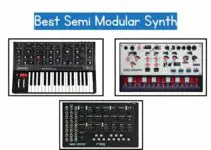If you have ever been to a music concert, a live show, an operatic performance or even a live recording, you might have noticed singers using something that looks like an earpiece while performing. Some insert it into only one ear while some use it in both ears.
In some cases, you will even notice that it is not only the singer that uses these devices on stage. The bassist, guitarist, pianist, drummer, and every other player might also be using it. These devices are not the conventional earpiece or earbuds that you use to enjoy music.
These devices are known as in-ear monitors (IEM) and they are classified as a type of earbud. When performing music, one of the most crucial factors that ensure good performance is the ears of the performer.
In the case of singers, it is very important they hear both themselves and the rest of the band while they are performing. Any slight deficiency in hearing (be it technical) can ruin the entire performance.
For even the most trained singer, they are likely to go offkey or off-beat or even both. It is very paramount that the singers hear themselves and the rest of the band.
Traditionally, stage monitoring (hearing) was always done with wedges. Just as the name suggests, wedges are wedge-shaped floor monitor loudspeakers.
Wedges are typically placed on stage to face the musicians and performers and play the music back towards them so that they can hear themselves just clearly. Some unverified history has it that the very first floor monitors (wedges) were used by The Beatles as far back as the 60s.
This was because they found it impossible to hear themselves over their loud and screaming spectators at the height of Beatlemania. Their sound engineers made a decision to simply turn some of the monitors (speakers) that would’ve been facing the crowd to face the Beatles instead.
As technology evolves, the music industry progressed from wedges to in-ear monitors (they often use both). So, singers use in-ear monitors (IEM) to hear themselves on stage while performing. It gives a more consistent, precise, danger-free, and versatile, hearing on stage.
Table of Contents
A Brief History of In-Ear Monitors and Stage Monitoring
Before in-ear monitors, stage monitoring relied on traditional floor monitors (wedge monitors). These were essentially speakers placed on the stage floor, facing the musicians and projecting sound back to them.
However, this setup was limited, as it often led to sound bleed and feedback issues, especially in loud concerts and performances.
The concept of in-ear monitors can be traced back to the early 1970s when musicians and audio engineers began experimenting with rudimentary homemade versions.
These early IEMs were often improvised by attaching standard earphones (earbuds) to small radio packs or receivers. These radio packs were typically borrowed from wireless communication devices or FM receivers.
Musicians used these makeshift in-ear monitors to address some of the challenges associated with traditional stage monitoring using floor wedges. They could create a more isolated and focused listening experience by placing the earphones directly in their ears.
Then, in the early 1980s, the first in-ear monitors were developed by Jerry Harvey, a sound engineer for Van Halen, to address the challenges of traditional stage monitoring. These early IEMs were custom-moulded earpieces with drivers that could be inserted into musicians’ ears.
The concept aimed to provide a more controlled and isolated listening experience, reducing stage volume and improving overall sound quality for performers. In-ear monitors quickly gained popularity in the professional music industry, especially among touring musicians and bands.
The ability to control the mix of individual instruments and vocals directly in the ears of the musicians offered significant advantages in terms of sound clarity, reduced stage clutter, and improved communication on stage.
As the demand for in-ear monitors grew, technological advancements allowed for more sophisticated designs. Standardized universal-fit IEMs became available, providing off-the-shelf options for musicians.
Additionally, wireless systems became prevalent, enabling musicians to move freely on stage without being tethered to a mixer. While initially popular in the music industry, in-ear monitors found applications in other fields as well.
Television presenters, public speakers, and even some audiophiles embraced IEMs for their noise isolation and personalized listening experience. As technology continues to advance, it is likely that in-ear monitors will become even more sophisticated, compact, and feature-rich.
The focus may shift towards incorporating biometric sensors, allowing musicians to monitor vital signs like heart rate and body temperature during performances.
What Are the Major Problems Singers Face On Stage While Singing?
Singers and musicians face several challenges on stage while singing, and many of these challenges are related to monitoring issues.
Monitoring is crucial for performers to hear themselves and other instruments or vocals clearly, ensuring they stay in tune and sync with the rest of the band. Here are some major problems singers and musicians may encounter with on-stage monitoring:
- Insufficient Volume or Clarity or Insufficient hearing
If the monitor mix is too low or unclear, singers and musicians may struggle to properly hear themselves and their fellow performers. That can lead to pitch and timing inaccuracies, affecting the overall performance quality. - Feedback and Sound Bleed
Traditional floor wedges can cause sound to bleed into microphones, leading to feedback issues. Additionally, if the stage volume is too high, it can result in a vicious cycle of feedback, making it challenging for singers and musicians to hear anything clearly. - Imbalanced Mix
A poorly balanced monitor mix can be problematic. If certain instruments or vocals dominate the mix, it can be challenging for performers to hear everything they need to, leading to confusion and potential performance errors. - Cabling and Mobility
Wired monitoring systems can restrict movement on stage, limiting performers’ ability to interact with the audience or other band members freely. - Isolation from Ambient Sound
While in-ear monitors provide excellent isolation, also, the complete removal of ambient sound can hinder communication among band members and lead to a disconnection from the audience. - Lack of Personalization
Different performers have varying preferences for their monitor mix. What works for one singer or musician may not suit another. When each performer’s mix is not tailored to their needs, it can impact their ability to perform at their best. - Stage Positioning
The location of the monitors on stage can also be a problem. If a singer or musician is too far away from the monitors, they may not be able to hear adequately, while being too close might lead to an overwhelming volume. - Hearing Damage
If the stage volume or monitor mix is too loud, it can potentially lead to hearing damage for performers, affecting their long-term hearing health.
Why Do Singers Wear An Earpiece? – Why Singers Use IEM
In-ear monitors have become an essential tool for professional singers and musicians due to the following benefits:
- Personalized Monitor Mix
In-ear monitors allow singers to have a custom mix of instruments, vocals, and other sound elements directly in their ears. This personalized mix helps them hear themselves and other band members a lot more clearly on stage, improving overall performance quality. - Noise Isolation
IEMs provide excellent noise isolation, blocking out ambient sound and stage noise. This isolation allows singers to focus solely on the monitor mix, reducing the risk of distractions and helping them stay on pitch and in sync with the music. - Feedback Prevention
Traditional floor monitors can cause sound to bleed into microphones, leading to feedback issues. In-ear monitors, inserted directly into the ears, eliminate this problem, thereby resulting in a cleaner and more controlled sound. - Reduced Stage Volume
With IEMs, musicians can hear the mix directly in their ears, reducing the need for loud stage volume. Lower stage volume benefits everyone on stage, as it minimizes sound bleed and creates a more pleasant listening environment for both performers and the audience. - Mobility and Freedom
Wireless in-ear monitor systems allow singers and musicians to move freely on stage without being tied to a specific monitor position. That enhances stage presence and performance dynamics. - Hearing Protection
In-ear monitors can act as earplugs, providing some level of hearing protection by reducing exposure to high-stage volume and ambient noise. - Consistent Sound
In venues with varying acoustics, IEMs provide consistent sound for singers regardless of the stage setup, ensuring they can deliver a reliable performance night after night. - Communication
Some in-ear monitoring systems include built-in communication capabilities, allowing singers to communicate with band members or the audio engineer during the performance without relying on stage monitors. - Stage Clutter Reduction
IEMs eliminate the need for floor wedges, reducing stage clutter and creating a cleaner, more organized stage setup.
Why Do Some Singers Still Take In-ears Off While Singing?
Some singers/musicians prefer not to use in-ear monitors while performing due to the following reasons:
- Comfort
While modern IEMs are designed for comfort, some singers may find wearing them for extended periods uncomfortable, especially if they are not used to the sensation of having earpieces in their ears. - Connectivity or Technical Issues
In-ear monitor systems rely on wireless technology and connections to transmit the audio mix to the singer. If there are connectivity or technical issues during a performance, the singer might take off the IEMs to troubleshoot the problem or rely on traditional floor monitors as a backup. - Hearing the Audience
Some singers prefer to hear the audience’s reactions and applause during their performance. IEMs, with their excellent noise isolation, can block out most ambient sounds, including the audience. - Communication with Band Members
In-ear monitors with communication capabilities allow band members to communicate discreetly during a performance. However, some singers may prefer face-to-face communication or hand signals, especially in smaller, intimate settings. - Maintaining Vocal Connection
Some singers feel that wearing IEMs creates a sense of detachment from their voice, making it harder for them to connect emotionally with the song and performance. - Stage Presence and Interaction
For some performers, removing the IEMs allows them to engage more with the audience and other band members on stage, as they don’t have to worry about the presence of the earpieces, and they can easily hear them and their responses.
Pros and Cons of In-Ear Monitors
| Pros: | Cons: |
| Personalized mix: As a singer, you get customized sound tailored to individual preferences. | Initial cost: High-quality IEMs can be expensive to purchase. |
| Noise isolation: Blocks out ambient noise, reducing stage volume and feedback issues. | Learning curve: Requires some adaptation and familiarization, especially for first-time users. |
| Mobility: Wireless IEMs offer freedom of movement on stage. | Isolation from the audience: Blocks out ambient crowd noise, limiting the performer’s connection with the audience. |
| Hearing protection: Helps protect performers’ hearing from excessive stage volume. | Technical issues: Wireless systems may encounter connectivity or interference problems. |
| Consistent sound: Ensures a consistent monitor mix in different venues. | Comfort: Some singers and musicians find IEMs uncomfortable for extended use. |
| Reduced stage clutter: Replaces the need for bulky floor wedges, creating a cleaner stage setup. | Dependence on technology: Malfunctions or battery issues can disrupt performances. |
| Lack of awareness: Complete isolation can hinder situational awareness on stage. | |
| Fit issues: Ensuring a proper fit may require custom moulding for optimal comfort and performance. |
In-Ear Monitors vs Eearbuds: How Different Are They?
In-ear monitors (IEMs) and earbuds share a similar design, fitting snugly inside the ear canal, but they serve distinct purposes and cater to different audio needs.
In-ear monitors are professional and specialized audio devices primarily used by musicians and performers during live stage performances or in recording studios.
They offer high-fidelity sound reproduction with accurate and detailed audio, allowing musicians to hear a personalized mix of instruments and vocals. Custom-moulded IEMs ensure a secure and comfortable fit, providing excellent noise isolation and bass response.
Wireless IEM systems enable performers to move freely on stage without being tethered by cables. However, professional-grade IEMs can be expensive due to their advanced features and tailored design.
Conversely, earbuds are consumer audio devices commonly used for personal listening to music or other content on portable devices. While some earbuds offer decent sound quality, they generally do not match the precision and fidelity of high-end IEMs.
They come in standardized sizes and may not provide the same custom fit and noise isolation level as IEMs. They are available in wired and wireless versions, offering greater affordability than professional-grade IEMs.
Next, Bluetooth earbuds may have latency, resulting in performance issues. Earbuds are not intended for stage monitoring or critical listening scenarios but for convenient, everyday personal listening.
Top 5 In-Ear Monitor Brands
- Shure
- Westone
- Ultimate Ears (UE)
- Sennheiser
- JH Audio (Jerry Harvey Audio)
Conclusion
In-ears are almost necessary for you if you perform live, as they protect your ears in loud venues, and let you have separate personalized mixes by which you can monitor your voice or instrument better.
It also has several other benefits like noise isolation, feedback prevention, reduced stage volume, and better mobility.
Although n-ears can be expensive and may have some hassle, we still suggest investing in them so you can play and perform long-term and avoid any auditory accidents.
They can also help you stay on pitch, maintain synchronization with the band, and deliver consistent performances. We hope the article helps. Thank you for reading.





